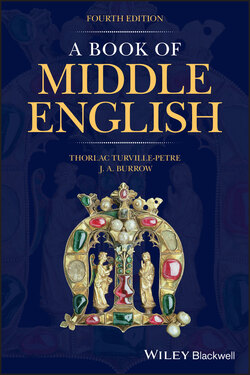Читать книгу A Book of Middle English - J. A. Burrow - Страница 27
4.1.2 Loss of Inflexional Endings
ОглавлениеBy comparison with Modern English, Old English was highly inflected. In Late Old English there was a gradual loss of distinctiveness in inflexional endings and short vowels in unstressed syllables were progressively simplified, until by the eleventh century in most dialects they had all been reduced to one, usually written e, and sounded as /ə/ (the final sound of Modern English ‘China’). In addition, the dative ending ‐um had in Late Old English become /ən/, which in Middle English was written as ‐en. These early sound‐changes had profound consequences for the system of inflexions as well as for the distinctions in grammatical gender that depended upon that system.
Two rather later sound‐changes that had further effects upon inflexions were the loss in unstressed syllables of final ‐n after ‐e, and then the loss of final ‐e itself. To take as an example the infinitive of a verb: drincan in Old English became drinken in Early Middle English (as in 4/68), then drinke, and finally drink. This last stage was reached during the thirteenth century in parts of the North, and had probably extended to the whole country by the beginning of the fifteenth century, although the situation is obscured by the tendency of later scribes to add final ‐e when it was not sounded.
The process of change and simplification advanced at very different rates in the various dialects of Middle English. The earliest Middle English texts of the North and East already have a system of inflexions radically different from that of standard written Old English, while the dialects of the South and West were much less innovative, no doubt partly because they were less sharply brought up against the language of the Scandinavian settlers. These variations in the pace of development are strikingly illustrated by a comparison of the earliest of our texts, the mid‐twelfth‐century Peterborough Chronicle from the North‐East Midlands (text 1), with three late twelfth‐ and thirteenth‐century texts from the South and from the South‐West Midlands, The Owl and the Nightingale, Laʒamon’s Brut and the Ancrene Wisse (texts 2–4). In very many respects the language of these latter works is much more conservative than that of The Peterborough Chronicle, and represents a transitional system undergoing a process of simplification and loss that was already well advanced in the North and East.
